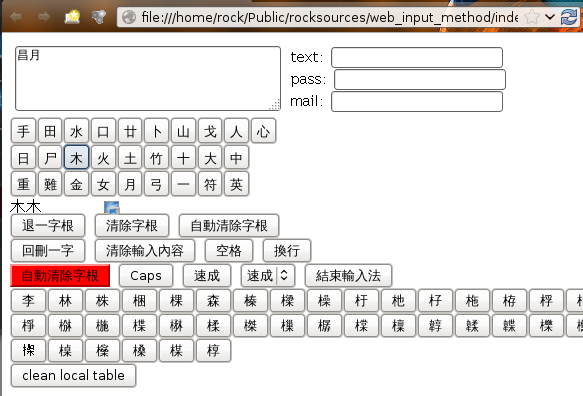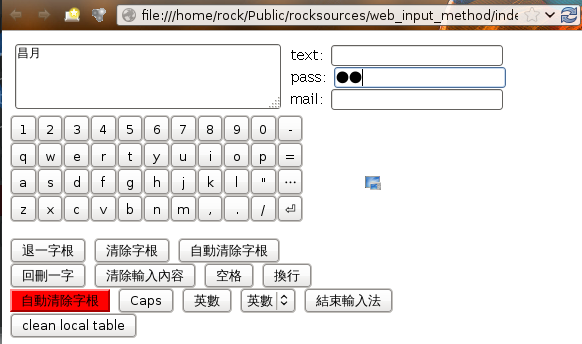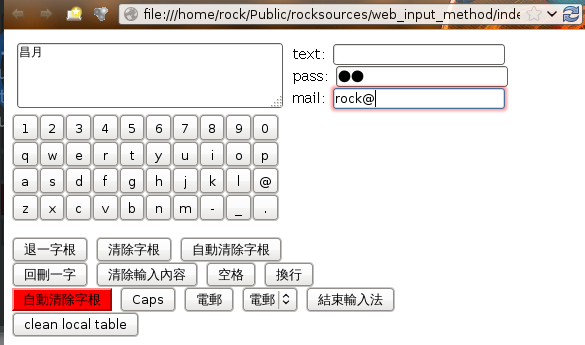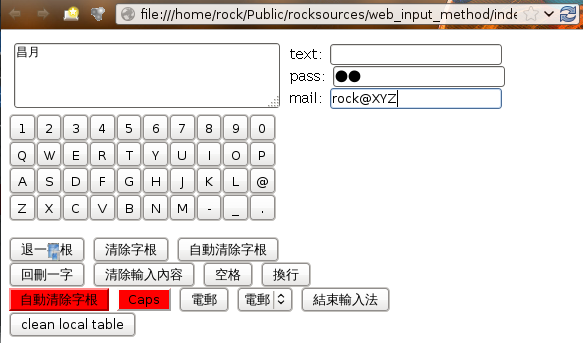Touch IME HTML5 輸入法引擎使用手冊
Touch 輸入法 Copyright (C) 2013 遊手好閒的石頭成 <shirock.tw@gmail.com>
Touch IME is free software: you can redistribute it and/or modify
it under the terms of the GNU Lesser General Public License as published by
the Free Software Foundation, either version 3 of the License, or
any later version.
This program is distributed in the hope that it will be useful,
but WITHOUT ANY WARRANTY; without even the implied warranty of
MERCHANTABILITY or FITNESS FOR A PARTICULAR PURPOSE. See the
GNU Lesser General Public License for more details.
You should have received a copy of the GNU Lesser General Public License
along with this program. If not, see
<https://www.gnu.org/licenses/lgpl-3.0-standalone.html>.
You should see https://rocksources.googlecode.com/ to get more information about Touch IME.

概觀
TouchInputMethod (以下稱 touch-ime ) 是針對純觸控螢幕、無鍵盤環境的 HTML5 應用軟體設計的輸入法引擎。
使用特徵:
- 焦點進入輸入框時,便會出現鍵盤。一般設計時亦可採固定顯示。
- touch-ime 會記憶最近使用的輸入框。就算使用者碰觸其他區域使焦點離開輸入框, touch-ime 還是會把輸入內容填入預期的輸入框。
- 點擊鍵盤上的「結束輸入法」鍵,則會收起鍵盤。
- touch-ime 可以在失去焦點的狀態下,繼續輸入工作。所以不會以「失去焦點」為時間點自動收起浮動鍵盤。
- 選取特定型態輸入框時 (password, mail) ,會出現對應型態的鍵盤佈局。
- touch-ime 會記憶單純文字型態 (text) 的輸入框使用的輸入法引擎,而不是每次都使用預設輸入法引擎。
- 可擴展的輸入法引擎以及可自定的鍵盤佈局。
- 可自定詞庫與常用符號表。
目前提供下列輸入法與鍵盤佈局:
- 英數: en
- 行列30: array30
- 注音: zhuyin
- 拼音 (漢語拼音): pinyin
- 倉頡速成 (快速倉頡): quick
- 倉頡三代: cangjie3
- 電子郵件型態輸入元件適用的鍵盤佈局: email
source repo: https://github.com/shirock/rocksources/tree/master/web/touch-ime
源碼安裝: 你需要下載所有的 .js 文件和 .tab 文件。
範例文件:
- index.html - 一般使用範例。由頁面設計者安排輸入法控制項的位置。
- offline.html - 離線使用範例。如何透過 Cache 機制,在不連接網路的狀態下使用 touch-ime 。
- on-screen-keyboard-demo.html - 配合 touch-ime 的 OSD Keyboard 範例。
deb安裝: 安裝 touch-ime 。檔案將被安裝在 /usr/share/javascript/touch-ime 。以瀏覽器開啟範例文件,例如 file:///usr/share/javascript/touch-ime/index.html (部份瀏覽器不允許開啟 file:// 協定) 。
參考: Touch IME 介紹。
使用情境 (index.html)
畫面上有4個輸入項目,使用者點取第一個文字輸入區,並切換到速成輸入法輸入。

使用者點取 pass 欄位,因為該欄位的型態是 password ,故 touch-ime 自動切換到英數輸入。

使用者點取 mail 欄位,因為該欄位的型態是 email ,故 touch-ime 自動切換到電郵輸入。

使用者點擊 Caps (大寫變換) 輸入法控制項,鍵盤區鍵面符號變大寫,出字也變大寫。

用例
<script src="touch-ime.js" type="text/javascript">
</script>
<input type="text" />
<input type="email" />
<textarea>
</textarea>
<div><!-- optional -->
<button class="input_method_back_input_key">退一字根</button>
<button class="input_method_clear_input_keys">清除字根</button>
<button class="input_method_auto_clear_input_keys_mode">自動清除字根</button>
<button class="input_method_capital_toggle">Caps Lock</button>
<button class="input_method_backspace_output_texts">回刪一字</button>
<button class="input_method_clear_output_texts">清除輸入內容</button>
<button class="input_method_add_space_output_texts">空格</button>
<button class="input_method_add_newline_output_texts">換行</button>
<button class="input_method_switch_engine">切換</button>
<button class="input_method_end_composition">結束輸入法</button>
</div>
<div id="input_method_keyboard"><!-- required -->
</div>
<div id='input_method_show_input_keys'><!-- required -->
</div>
<div id='input_method_candidate'><!-- required -->
</div>何時需要 touch-ime
基本上,如果你的 HTML5 應用軟體是執行在移動式環境的作業系統,例如 Firefox OS 、 Tizen 、Windows Phone 等。它們本身就已經提供了完善的輸入法系統,你不需要 touch-ime 。
再者,若你的 HTML5 應用軟體執行在客製化的 Linux 桌面環境,那麼你首先應該考慮的輸入方案是使用 On-Screen 鍵盤 (軟體虛擬鍵盤) 。On-Screen 鍵盤可以輕易地和系統內建的輸入法系統,如 IBus, SCIM 等互動,達成使用者輸入的需求。這也是 [https://www.w3.org/TR/ime-api/ W3C Input Method Editor API] 目前建議的方式。
唯有你的系統不提供你需要的中文輸入法,或者你無法操控 On-Screen 鍵盤時,你才需要考慮使用 touch-ime 。
基本說明
- 載入 Touch 輸入法的程式碼: touch-ime.js (以下稱 touch-ime)。
- 提供三個 touch-ime 要用的 div 。
- 以 style class 指定其他輸入法控制項。
基本上,你只需要載入 touch-ime.js 並確保你的 HTML 中有下列 3 個必要的 div ,touch-ime 就可運作了。但缺少選用性的輸入法控制項目時,例如切換輸入法、刪字、空格等,使用者會覺得相當不便。所以建議你應考慮畫面佈局,安排輸入法控制項。
touch-ime 不會決定輸入法鍵盤區在你畫面上的佈局或位置,也不會自己用突現式或漂浮式的呈現形式出現。它需要的鍵盤區、候選字區、控制項區的位置,交由設計者(也就是你)安排。還有,輸入法控制項的外觀,也交由設計者以 CSS 設計。
touch-ime 必要的 div 預設 id
- input_method_keyboard : 輸入法鍵盤區。
- input_method_candidate : 輸入法候選字區。候選字數可能超過可見範圍,故應允許此區域可以捲動內容,以便使用者滑動選字區內容挑字。
- input_method_show_input_keys: 輸入法已輸入字根的顯示區。
以上三區是必要項目,而且必須是唯一的,所以用 id 識別。
touch-ime 選用性的輸入法控制項的預設 style class
- input_method_inputkey : 字根鍵盤外觀。
- input_method_candidates : 候選字外觀。
- input_method_back_input_key : 「退一字根」控制項與外觀。
- input_method_clear_input_keys : 「清除字根」控制項與外觀。
- input_method_auto_clear_input_keys_mode : 「自動清除字根」控制項與外觀。
- input_method_auto_clear_input_keys_on : 自動清除功能鈕啟動時外觀。
- input_method_capital_toggle : 「Caps」控制項與外觀。
- input_method_capital_toggle_on : Caps 啟動時外觀。
- input_method_backspace_output_texts : 「回刪一字」控制項與外觀。
- input_method_clear_output_texts : 「清除輸入內容」控制項與外觀。
- input_method_select_output_texts: 「選取輸入內容」控制項與外觀。
- input_method_add_space_output_texts : 「空白」控制項與外觀。
- input_method_add_newline_output_texts : 「換行」控制項與外觀。
- input_method_switch_engine : 「切換輸入法」控制項與外觀。
- input_method_select_engine : 「選擇輸入法」控制項與外觀。這必須是 select 控制項。
- input_method_goto_next: 「移到下一欄位」控制項與外觀。
- input_method_goto_previous: 「移到上一欄位」控制項與外觀。
- input_method_end_composition : 「結束輸入法」控制項與外觀。
以上輸入法控制項是可選用的,可有可無。甚至同樣功能的控制項也可以安排兩個或多個,所以它們用 style class 識別。
自訂功能
TouchIME 方法與屬性
進階自訂項目需要使用 JavaScript 操作。
指定輸入法控制項 set_controls
touch-ime 提供 TouchInputMethod.set_controls() 方法讓設計者自訂控制項的 id 和 style class 。
TouchInputMethod.set_controls(custom_keyboard_id, custom_candidate_id,
custom_show_input_keys_id, optional_classes);三個必要的 div id ,若給 null 表示用預設值。
optional_classes 為 Hash table,用於自訂輸入法控制項的 style class 名稱。可用的參數項如下列:
- inputkey 字根鍵盤外觀的 style class 名稱。
- candidates 候選字外觀的 style class 名稱。
- back_input_key 「退一字根」控制項與外觀的 style class 名稱。
- clear_input_keys 「清除字根」控制項與外觀的 style class 名稱。
- auto_clear_input_keys_mode 「自動清除字根」控制項與外觀的 style class 名稱。
- auto_clear_input_keys_on 自動清除功能鈕啟動時外觀的 style class 名稱。
- capital_toggle 「Caps」控制項與外觀的 style class 名稱。
- capital_toggle_on Caps 啟動時外觀的 style class 名稱。
- backspace_output_texts 「回刪一字」控制項與外觀的 style class 名稱。
- clear_output_texts 「清除輸入內容」控制項與外觀的 style class 名稱。
- select_output_texts: 「選取輸入內容」控制項與外觀的 style class 名稱。
- add_space_output_texts 「空白」控制項與外觀的 style class 名稱。
- add_newline_output_texts 「換行」控制項與外觀的 style class 名稱。
- switch_engine 「切換輸入法」控制項與外觀的 style class 名稱。
- select_engine 「選擇輸入法」控制項與外觀的 style class 名稱。這必須是 select 控制項。
- goto_next: 「移到下一欄位」控制項與外觀的 style class 名稱。
- goto_previous: 「移到上一欄位」控制項與外觀的 style class 名稱。
- end_composition 「結束輸入法」控制項與外觀的 style class 名稱。
get_controls
get css selector (id and class) of controls.
指定組字結果的輸出目標控制項 set_target
TouchInputMethod.set_target() 方法可指定組字結果的輸出目標控制項。
TouchInputMethod.set_target(dom);參數 dom 必須是一個 DOMInputElement 。
touch-ime 在載入時會自動綁定頁面上已有的輸入控制項,以偵測輸出目標。
但是,若設計者在頁面載入後才透過 JavaScript 新增輸入控制項,這些後來才增加的輸入控制項就不會為 touch-ime 所知。
此時設計者需要自行呼叫 set_target() 方法告知 touch-ime 將組字結果輸出到哪個控制項。
取得目前的輸出目標控制項 get_target
TouchInputMethod.get_target() 方法可取得目前的輸出目標控制項。
TouchInputMethod.get_target();回傳一個 DOMInputElement 。
不要用這個方法取得目前焦點所在的控制項,結果可能不同你預期。
指定資源目錄路徑 set_resources_path
TouchInputMethod.set_resources_path(resources_folder_path);預設是從 touch-ime.js 相同目錄下載入字根表等內容。
請注意瀏覽器的相同來源政策,如果你的字表資源放在不同來源伺服器,那麼你必須按照 W3 CORS 的建議,設置跨來源資源分享規則。若未設置 CORS ,那麼你在此只能指定資源目錄的路徑。例如 ‘/js/touch-ime/’ 。
參考:
- https://www.w3.org/TR/cors/
- https://en.wikipedia.org/wiki/Cross-origin_resource_sharing
啟用輸入法引擎 enable_engines
指定啟用哪些輸入法引擎。
TouchInputMethod.enable_engines(engine_code_list);參數 engine_code_list 是一個列出輸入法引擎代碼名的陣列。
目前有效的代碼名:
- zhuyin 注音
- pinyin 拼音
- en 英數
- enShift 英數大寫
- email 電子郵件
- array30 行列30
- cangjie3 倉頡第三代
- cangjie5 倉頡第五代
- quick 倉頡速成
預設啟用 zhuyin, en, email, pinyin, quick, array30 。
改變目前的輸入法引擎 change_engine
改變目前的輸入法引擎。
TouchInputMethod.change_engine(engine_code);參數 engine_code 必須是一個有效的輸入法引擎代碼名。如果無法切換指定的輸入法引擎,則回傳 false 。
指定控制項自動適用的輸入法引擎 specify_control_with_engine
TouchInputMethod.specify_control_with_engine(control_class, engine_code);control_class 表示控制項的 class 或 type 。若 engine_code 為 false ,則移除適用規則。
touch-ime 預設下列 type 控制項適用對象:
- ‘password’: ‘en’
- ‘datetime’: ‘en’
- ‘date’: ‘en’
- ‘month’: ‘en’
- ‘week’: ‘en’
- ‘time’: ‘en’
- ‘localdatetime’: ‘en’
- ‘number’: ‘en’
- ‘range’: ‘en’
- ‘email’: ‘email’
除了這些預設對象,設計者還可利用 specify_control_with_engine() 指定控制項的適用輸入法。其規則為:
- 如果控制項的 class 清單中 包含 了 control_class ,則適用指定的輸入法。 大部份設計者使用這個規則。
- 如果控制項的 type 等於 control_class ,則適用指定的輸入法。 基本上 touch-ime 預設的適用表已符合使用情境,不需要使用此規則改變。
- 以上皆非,則適用使用者手動選擇的輸入法。 手動選擇是指使用者透過「切換輸入法」、「選擇輸入法」或調用
change_engine()選擇輸入法的行為。
當使用者點取文字輸入控制項時, touch-ime 就會根據適用規則,自動切換輸入法,避免使用者自己切換輸入法的困擾。
清除本地儲存的特殊字表 clean_local_table
TouchInputMethod.clean_local_table();自本地儲存區 (localStorage) 中清除下列特殊字表的內容。
- en.tab (localStorage 名稱 input_method_en) 英數字元表。
- s.tab (localStorage 名稱 input_method_s) 詞庫表。
- w.tab (localStorage 名稱 input_method_w) 全形符號表。
- ascii.tab (localStorage 名稱 input_method_ascii) 半形符號表。
touch-ime 會讀取特殊字表檔的內容並保存在本地儲存區。如果你修改了特殊字表檔的內容,則你必須調用 clean_local_table() 清除已儲存的內容,touch-ime 才會重新讀取新的特殊字表檔內容(並再次保存於本地儲存區)。
組字事件 oncomposition
TouchInputMethod.oncomposition 屬性可指定組字時的處理行為。
當使用者點取可以輸入文字的頁面控制項時,就會觸發此事件。
結束組字事件 oncompositionend
TouchInputMethod.oncompositionend 屬性可指定結束組字時的處理行為。
只有使用者按下 end_composition 控制項時才會觸發此事件。
大寫變換模式事件 oncapitalization
此事件會傳入一個參數告知目前的大寫變換模式狀態。
加入更多的輸入法
若要擴充輸入法內容,需要編輯輸入法表格。
每一個輸入法都需要兩個表格,一為字根,一為鍵盤配置。分成 $PREFIX-tbl.js 和 $PREFIX-keyboard.js 。皆為 JSON 格式。
字根表 -tbl.js
字根為鍵,候選字為值,多個候選字間以逗號’,’分隔。
範例:
{
"1": "!,~",
"2": "@",
.
.(省略)
.
"enter": "\n"
}鍵盤表 -keyboard.js
需具備三個鍵:
- max_input_keys 型態為整數,指定此輸入法引擎最長的字根長度。預設為 4 。
- key_sym_map 型態為 hash table,指定字根值與鍵盤上顯示的符號。
- keyboard_layout 型態為陣列,表示鍵盤排列方式。以字根值為主,”\n” 表示換行排列。
範例:
{
"max_input_keys": 1,
"key_sym_map": {
"1": "!",
"2": "@",
.
.(省略)
.
"enter": "↙"
}
},
"keyboard_layout": [
"1", "2", "3", "4", "5", "6", "7", "8", "9", "0", "minus", "\n",
"q", "w", "e", "r", "t", "y", "u", "i", "o", "p", "plus", "\n",
"a", "s", "d", "f", "g", "h", "j", "k", "l", "slash", "\n",
"z", "x", "c", "v", "b", "n", "m", "<", ">", "enter"
]
}特殊字表
以下三個字表檔與輸入法引擎無關,屬於通用項目。
- en.tab 英數字元表。字根為 ‘~en’ 。
- s.tab 自定的常用詞表。字根為 ‘~s’ 。
- w.tab 標點符號表。字根為 ‘~w’ 。
字根若為 ‘~’ 開頭者,就視為特殊字表用字根。輸入法引擎製表時請勿使用此字元作為字根。
進階用例
載入 touch-ime.js 後,加上 JavaScript 程式碼,於程式碼中調用 touch-ime 提供的設定內容。
<script src="touch-ime.js" type="text/javascript">
</script>
<script>
TouchInputMethod.set_resources_path('/js/touch-ime/');
// 指定字表檔的路徑。
TouchInputMethod.set_controls(
'my_ime_keyboard',
'my_ime_candidate',
'my_ime_show_codes',
{
'clear_input_keys': 'my_ime_clear_input_codes',
'backspace_output_texts': 'my_ime_backspace',
'add_space_output_texts': 'my_ime_add_space',
'add_newline_output_texts': 'my_ime_add_newline',
'end_composition': 'my_ime_end_composition'
}
);
TouchInputMethod.enable_engines(["en", "enShift", "zhuyin", "quick"]);
// 啟用英數、注音和倉頡速成。
TouchInputMethod.specify_control_with_engine("phone_number", "en");
// 指定 class 包含 'phone_number' 的控制項適用 en 輸入。
TouchInputMethod.oncomposition = function() {
console.log("show TouchInputMethod");
document.getElementById('my_ime_area').style.visibility = "visible";
}
TouchInputMethod.oncompositionend = function() {
console.log("hide TouchInputMethod");
document.getElementById('my_ime_area').style.visibility = "hidden";
}
</script>
<input type="text" />
<input class="phone_number" type="text" />
<input type="email" />
<textarea>
</textarea>
<div id="my_ime_area" style="visibility:hidden;">
<div><!-- optional -->
<button class="my_ime_clear_input_codes">清除字根</button>
<button class="my_ime_backspace">回刪一字</button>
<button class="my_ime_add_space">空格</button>
<button class="my_ime_add_newline">換行</button>
<button class="my_ime_end_composition">結束輸入法</button>
</div>
<div id="input_method_keyboard"><!-- required -->
</div>
<div id='input_method_show_input_keys'><!-- required -->
</div>
<div id='input_method_candidate'><!-- required -->
</div>
</div>離線應用
若需要離線應用,請參考 touch-ime.manifest ,將其列出的檔名內容,加入你的快取清單中。
欲使快取清單生效,需要下列條件配合:
一、以 Apache http server 為例,需要在 mime.types 中加入下列設置:
text/cache-manifest manifestmime.types 的路徑,依你的 Apache 設置而定。可能位在 /etc/httpd/mime.types 、 /etc/apache2/mime.types 、或 /etc/mime.types 。
二、在你的網頁的 html 標籤中,增加 manifest 屬性,指出你的快取清單檔名。例如:
<html manifest="app.manifest">
.
. (省略)
.
</html>實際的離線應用案例,可參考「在 Windows Phone 8 上離線使用 Touch IME」。
附加 On Screen Keyboard
on-screen-keyboard.js 是一個以 HTML5 規格實作的軟體虛擬鍵盤 (OSD keyboard),故只能用於 HTML5 應用之內。嚴格說來它只是 On page display keyboard ,但為了方便查找,還是按正式說法的 On screen display keyboard 命名。
原本 touch-ime 的設計哲學是由 UI 設計者自行規劃輸入法與鍵盤的控制項佈局。不過針對 Embedded webkit 這類型的應用,若有一個可以無縫置入的軟體虛擬鍵盤會比較方便。所以我增加了這個附加項目。
on-screen-keyboard.js 的使用方式很簡單,將它放在 touch-ime.js 的後面即可。請看以下範例:
<script src="touch-ime.js" type="text/javascript"></script>
<script type="text/javascript">
// Put you touch-ime setup if you need.
</script>
<script src="on-screen-keyboard.js" type="text/javascript"></script>
<body>
Your page content.
</body>on-screen-keyboard.js 會在頁面載入完成後,安插一個隱藏的虛擬軟鍵盤節點,以便讓 touch-ime 使用。然後 on-screen-keyboard.js 會去傾聽 touch-ime 的 oncomposition 和 oncompositionend 事件,決定顯示或隱藏虛擬軟鍵盤。這個虛擬軟鍵盤懸浮在頁面上,使用者可以拖動其位置,以免其遮擋到頁面資訊。這些動作都是 on-screen-keyboard.js 內部處理負責的,程式設計人員基本上不必關心它。事實上,由於 on-screen-keyboard.js 的特殊設計,它是一個沒有名字可以指涉的黑箱,不開放任何行為給程式設計人員操作。它唯一開放的是它的源碼,所以想改變它就直接修改源碼吧。
on-screen-keyboard.js 具體的使用範例可以參考源碼中的 on-screen-keyboard-demo.html 或 「Touch IME 使用在嵌入 WebKit 的場合」。